Kingdom Plantae Family Lecythidaceae Species B. excelsa | Order Ericales Genus Bertholletia
Bonpl. | |
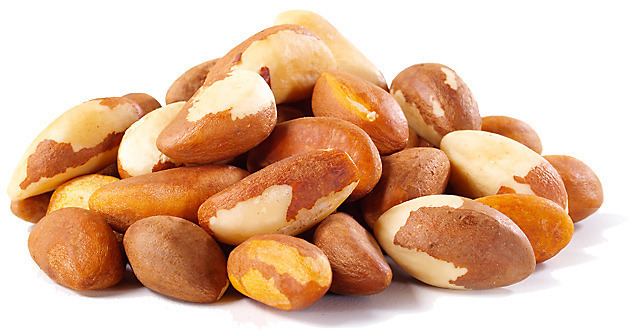 | ||
Similar Pecan, Macadamia, Cashew, Nut, Hazelnut | ||
The Brazil nut (Bertholletia excelsa) is a South American tree in the family Lecythidaceae, and also the name of the tree's commercially harvested edible seeds.
Contents
- Harvesting brazil nuts and timber in the peruvian amazon
- Order
- Brazil nut tree
- Hazards
- Reproduction
- Nomenclature
- Nut production
- Effects of harvesting
- Nutrition
- Brazil nut oil
- Other uses
- Wood
- References

Harvesting brazil nuts and timber in the peruvian amazon
Order
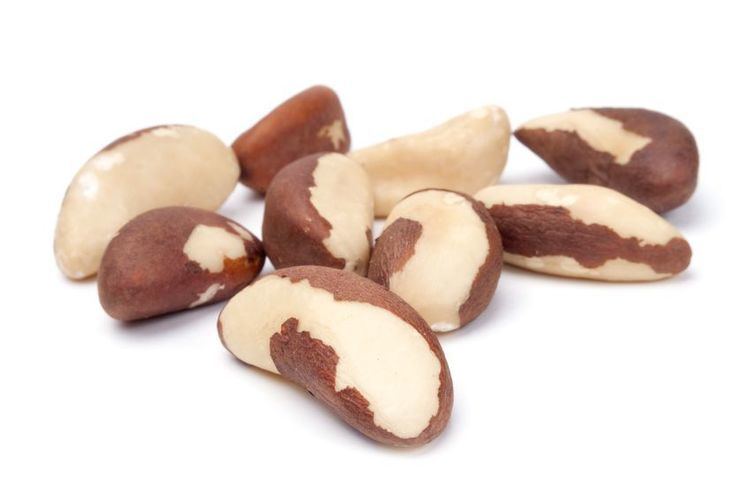
The Brazil nut family is in the order Ericales, as are other well-known plants such as blueberries, cranberries, sapote, gutta-percha, tea, gooseberries, phlox and persimmons.
Brazil nut tree

The Brazil nut tree is the only species in the monotypic genus Bertholletia. It is native to the Guianas, Venezuela, Brazil, eastern Colombia, eastern Peru, and eastern Bolivia. It occurs as scattered trees in large forests on the banks of the Amazon River, Rio Negro, Tapajós, and the Orinoco. The genus is named after the French chemist Claude Louis Berthollet.
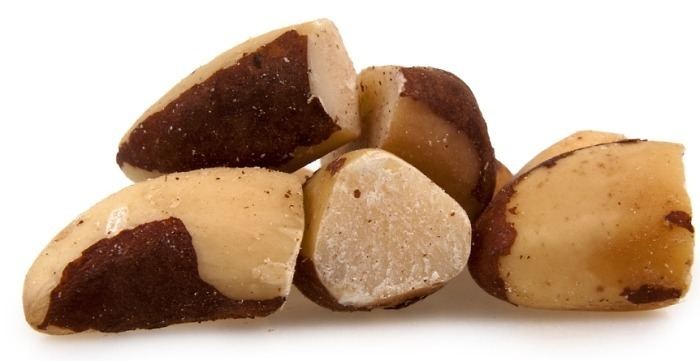
The Brazil nut is a large tree, reaching 50 m (160 ft) tall and with a trunk 1 to 2 m (3.3 to 6.6 ft) in diameter, making it among the largest of trees in the Amazon rainforests. It may live for 500 years or more, and according to some authorities often reaches an age of 1,000 years. The stem is straight and commonly without branches for well over half the tree's height, with a large emergent crown of long branches above the surrounding canopy of other trees.
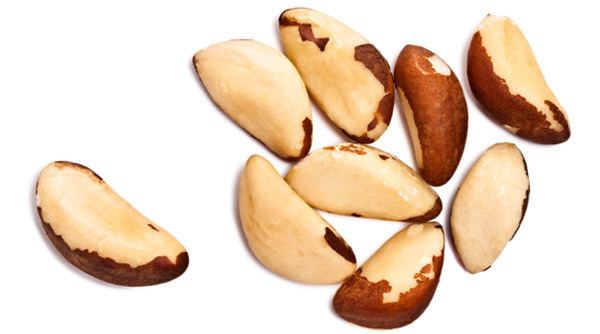
The bark is grayish and smooth. The leaves are dry-season deciduous, alternate, simple, entire or crenate, oblong, 20–35 cm (7.9–13.8 in) long and 10–15 cm (3.9–5.9 in) broad. The flowers are small, greenish-white, in panicles 5–10 cm (2.0–3.9 in) long; each flower has a two-parted, deciduous calyx, six unequal cream-colored petals, and numerous stamens united into a broad, hood-shaped mass.
Hazards
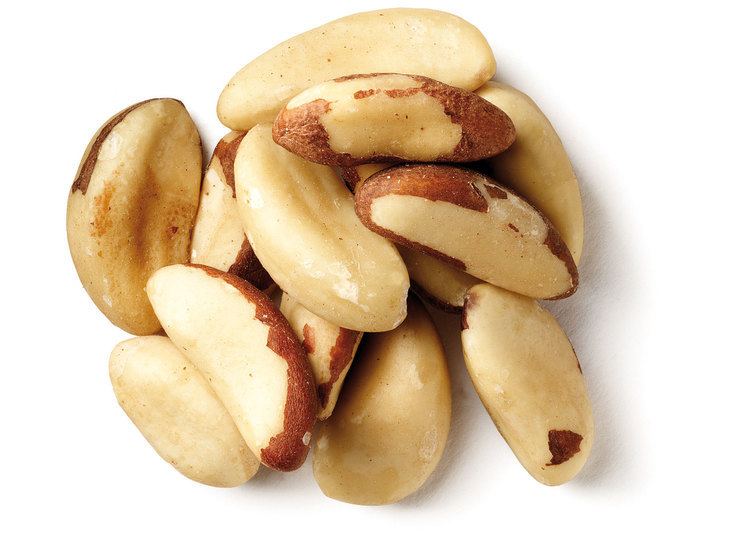
In Brazil, it is illegal to cut down a Brazil nut tree. As a result, they can be found outside production areas, in the backyards of homes and near roads and streets. The fruit containing nuts are very heavy and rigid, and they pose a serious threat to vehicles and people passing under the tree. Brazil nuts sink in fresh water, which can cause clogging of waterways in riparian areas.
Reproduction
Brazil nut trees produce fruit almost exclusively in pristine forests, as disturbed forests lack the large-bodied bees of the genera Bombus, Centris, Epicharis, Eulaema, and Xylocopa which are the only ones capable of pollinating the tree's flowers, with different bee genera being the primary pollinators in different areas, and different times of year. Brazil nuts have been harvested from plantations, but production is low and is currently not economically viable.

The fruit takes 14 months to mature after pollination of the flowers. The fruit itself is a large capsule 10–15 cm (3.9–5.9 in) in diameter, resembling a coconut endocarp in size and weighing up to 2 kg (4.4 lb). It has a hard, woody shell 8–12 mm (0.31–0.47 in) thick, which contains eight to 24 triangular seeds 4–5 cm (1.6–2.0 in) long (the "Brazil nuts") packed like the segments of an orange.
The capsule contains a small hole at one end, which enables large rodents like the agouti to gnaw it open. They then eat some of the seeds inside while burying others for later use; some of these are able to germinate into new Brazil nut trees. Most of the seeds are "planted" by the agoutis in shady places, and the young saplings may have to wait years, in a state of dormancy, for a tree to fall and sunlight to reach it, when it starts growing again. Capuchin monkeys have been reported to open Brazil nuts using a stone as an anvil.
Nomenclature
Despite their name, the most significant exporter of Brazil nuts is not Brazil but Bolivia, where they are called nuez de Brasil. In Brazil, these nuts are called castanhas-do-pará (literally "chestnuts from Pará"), but Acreans call them castanhas-do-acre instead. Indigenous names include juvia in the Orinoco area. In Cuba, the nut is alternatively called coquito de Santiago, literally St. James coconut.
Though it is commonly called the Brazil nut, in botanical terms it is the seed from the fruit of this tree. To a botanist, a nut is a hard-shelled indehiscent fruit. (An example of a botanical nut would be an acorn or a hazelnut.)
In North America, Brazil nuts are sometimes known by the epithet "nigger toes," though the term has fallen out of favor as public use of the racial slur became increasingly unacceptable by the 1960s. They can be seen being sold in a market under this name in a scene from the 1922 Stan Laurel film The Pest.
Nut production
Around 20,000 tons of Brazil nuts are harvested each year, of which Bolivia accounts for about 50%, Brazil 40%, and Peru 10% (2000 estimates). In 1980, annual production was around 40,000 tons per year from Brazil alone, and in 1970, Brazil harvested a reported 104,487 tons of nuts.
Effects of harvesting
Brazil nuts for international trade can come from wild collection rather than from plantations. This has been advanced as a model for generating income from a tropical forest without destroying it. The nuts are gathered by migrant workers known as castanheiros.
Analysis of tree ages in areas that are harvested show that moderate and intense gathering takes so many seeds that not enough are left to replace older trees as they die. Sites with light gathering activities had many young trees, while sites with intense gathering practices had hardly any young trees.
Statistical tests were done to determine what environmental factors could be contributing to the lack of younger trees. The most consistent effect was found to be the level of gathering activity at a particular site. A computer model predicting the size of trees where people picked all the nuts matched the tree size data gathered from physical sites that had heavy harvesting.
Nutrition
Brazil nuts are 14% protein, 12% carbohydrate, and 66% fat by weight; 85% of their calories come from fat, and a 100 g serving provides 656 total calories. The fat components are 23% saturated, 38% monounsaturated, and 32% polyunsaturated. Due to their high polyunsaturated fat content, primarily omega-6 fatty acids, shelled Brazil nuts may quickly become rancid.
Nutritionally, Brazil nuts are an excellent source (> 19% of the Daily Value, DV) of dietary fiber (30% DV) and various vitamins and dietary minerals. A 100 g serving (75% of one cup) of Brazil nuts contains rich content of thiamin (54% DV), vitamin E (38% DV), magnesium (106% DV), phosphorus (104% DV), manganese (57% DV) and zinc (43% DV) (right table). Brazil nuts are perhaps the richest dietary source of selenium, with a one-ounce (28 g) serving of 6 nuts supplying 774% DV. This is 10 times the adult U.S. Recommended Dietary Allowance, more even than the Tolerable Upper Intake Level, although the amount of selenium within batches of nuts varies greatly.
The European Union has imposed strict regulations on the import from Brazil of Brazil nuts in their shells, as the shells have been found to contain high levels of aflatoxins, which can lead to liver cancer.
Brazil nuts contain small amounts of radium, a radioactive element, in about 1–7 nCi/kg or 40–260 Bq/kg, about 1000 times higher than in several other common foods. According to Oak Ridge Associated Universities, this is not because of elevated levels of radium in the soil, but due to "the very extensive root system of the tree."
Brazil nuts are a common ingredient in mixed nuts where, because of their large size, they tend to rise to the top, an example of granular convection, which for this reason is often called the "Brazil nut effect."
Brazil nut oil
Brazil nut oil contains 75% unsaturated fatty acids composed mainly of oleic and linolenic acids, as well as the phytosterol, beta-sitosterol, and fat-soluble vitamin E.
The following table presents the composition of fatty acids in Brazil nut oil:
Other uses
As well as its food use, Brazil nut oil is also used as a lubricant in clocks, for making artists' paints, and in the cosmetics industry. Engravings in Brazil nut shells were supposedly used as decorative jewelry by the indigenous tribes in Bolivia, although no examples still exist. Because of its hardness, the Brazil nut's shell is often pulverized and used as an abrasive to polish materials such as metals and even ceramics (in the same way jeweler's rouge is used).
Wood
The lumber from Brazil nut trees (not to be confused with Brazilwood) is of excellent quality, but logging the trees is prohibited by law in all three producing countries (Brazil, Bolivia and Peru). Illegal extraction of timber and land clearances present a continuing threat.
